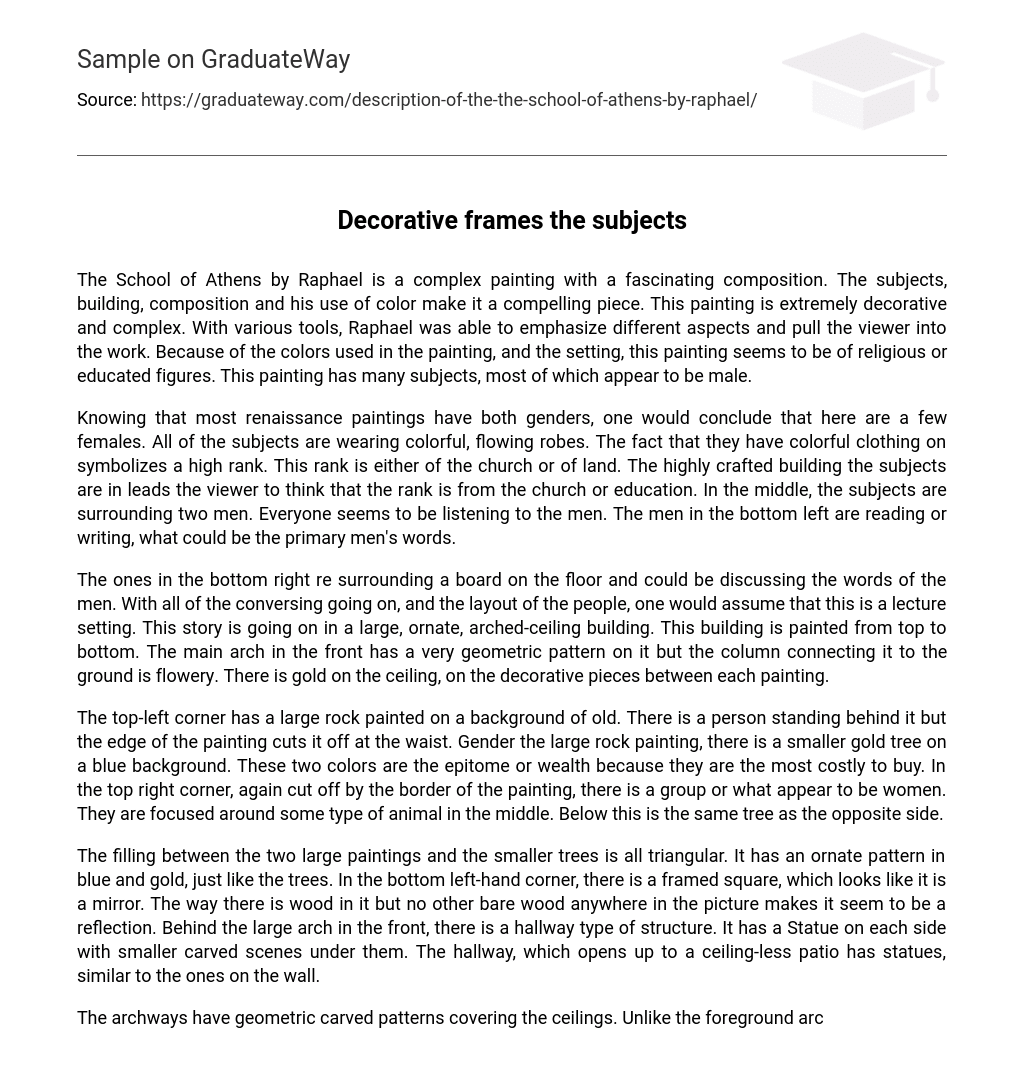The School of Athens, an intricately composed painting by Raphael, is both captivating and elaborate. Its subjects, architecture, composition, and color utilization contribute to its alluring nature. This artwork is highly ornamental and intricate. Through the use of diverse techniques, Raphael skillfully highlights various elements and immerses the viewer into the painting. The color palette and surroundings suggest that this piece pertains to religious or scholarly individuals. Moreover, the majority of the depicted subjects in this painting appear to be male.
It can be inferred from the presence of both genders in most renaissance paintings that there are a few females depicted here. The individuals portrayed are all adorned in vibrant, flowing robes, which signifies their elevated social status. This status is indicative of their affiliation with either the church or the land. The meticulously crafted building that serves as the backdrop for the subjects suggests that their rank and status may be derived from their association with the church or education. In the center of the painting, the subjects encircle two men, who seem to hold their attention. In the bottom left corner, some of the men can be seen engaged in reading or writing, possibly relaying important information.
The individuals positioned in the lower right corner are gathered around a board on the floor, possibly engaged in a discussion about the words spoken by the men. Given the level of conversation and the arrangement of the people, it is likely that this scene takes place in a lecture setting. The story unfolds within a grand, intricately designed building with an arched ceiling. The entire building is adorned with paint, extending from top to bottom. The primary arch at the front is decorated with a distinct geometric pattern, while the column connecting it to the ground features floral embellishments. Additionally, there are golden accents on the ceiling and ornamental pieces situated between each painting.
The top-left corner features a large rock painting against an aged background. Standing behind the rock is a person, although the painting cuts them off at the waist. Adjacent to the rock, a smaller gold tree stands out against a blue background. These colors symbolize wealth as they are the most expensive to purchase. At the top right corner, also cropped by the painting’s border, a group of women can be seen gathering around an unidentified animal. Below this scene, the same tree as the opposite side can be observed.
The triangular filling between the two large paintings and the smaller trees is decorated with an elaborate blue and gold pattern, matching that of the trees. Positioned in the bottom left-hand corner, there is a framed square that appears to be a mirror. It contains wood, contrasting with the absence of any other bare wood in the picture, suggesting that it is a reflection. In the background, behind the prominent arch, there is a hallway-like structure featuring statues on each side and smaller carved scenes beneath them. This hallway leads to a patio without a ceiling, where statues similar to those on the wall can be found.
The archways are adorned with intricate geometric carvings on their ceilings. The background arches, unlike the one in the forefront, are made of white stone devoid of any paint or gold embellishments. As the arches gradually diminish in size, the vast expanse of the sky starts to dominate the scenery, showcasing a pure blue hue with fluffy white clouds. This painting is highly lifelike thanks to its meticulous attention to ornamental details and the precise depiction of the architectural structure. The sense of perspective is flawlessly achieved, with larger objects occupying the foreground and smaller objects placed in the background. Unlike previous artworks, this building appears to invite viewers to wander through its passages.
The subjects are accurately scaled and depicted. In previous works, the most important characters were larger and placed in the middle. The arches show depth with varying values. To depict a light source from the right, the underside and right walls of the arches are darker. While the people on the sides are not exact replicas, their presence on both sides creates an approximate symmetry in the painting. The symmetrical characteristic is further highlighted by the evenness of the arches. The complexity of the figures adds interest to the composition of the image.
The building without people would be a subject of architectural analysis. The colors in the artwork attract the viewer’s attention. The limited use of gold, in comparison to other paintings, enhances the overall brightness of the piece. The robes in the painting display remarkable color selections. The individuals situated closer to the central figures are dressed in gowns showcasing primary and secondary colors, while those on the outer edges primarily wear clothing in tertiary colors. This distinction in clothing might be related to social class or emphasis. As previously mentioned, the central subjects hold significance, hence their robes are more vivid to make them stand out.
The front archway is highly decorative and serves as a frame for the subjects underneath it. In contrast, the arches in the background are less extravagant, causing the foreground with the people to stand out. As a result, this painting possesses numerous intricacies and elements that may easily be overlooked. Raphael emphasized specific parts of the painting by utilizing color and framing techniques. The overall context suggests that the subjects possess knowledge. Consequently, when considering the amalgamation of color, composition, and subjects, this painting emerges as a remarkable and noteworthy piece.





